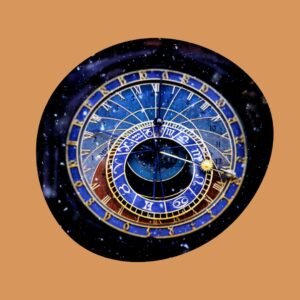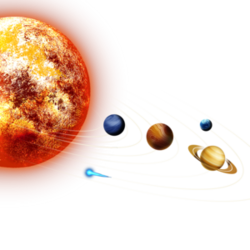9 Planets (Grahas) in Indian Astrology
Astrology and astronomy, two distinct yet intertwined sciences, use the terms “planet” and “star” differently. While astronomy defines a planet as a celestial body that orbits a star and is not a satellite of a planet, astrology uses the term to denote any celestial body that significantly influences human lives. In astrology, the Sun, the Moon, Mars and other planets are called “Grahas” or planets, as they significantly affect the activities of living beings on Earth.
Indian astrology is an ancient system of divination that has been practised for centuries. This system of astrology is based on the position of the celestial bodies and their influence on human life. In Indian astrology, seven primary celestial bodies, namely the Sun, Moon, Mars, Mercury, Jupiter, Venus, and Saturn, are believed to significantly impact human life. Each body has unique characteristics and influences different aspects of human life, such as personality, career, health, and relationships.

Besides these seven primary celestial bodies, two unique entities called Rahu and Ketu are also considered crucial in Indian astrology. These are not actual planets but shadow planets, also known as the ‘north node’ and the ‘south node,’ respectively. These shadow planets are mathematical points that are calculated based on the position of the Moon’s orbit. Despite their intangible nature, they are believed to impact human life significantly and are considered powerful influencers of human destiny.
Rahu is associated with desire, ambition, and worldly pursuits, while Ketu is related to spiritual growth, enlightenment, and detachment from earthly desires. The position of Rahu and Ketu in one’s birth chart can provide valuable insights into an individual’s strengths, weaknesses, and life path. In Indian astrology, studying Rahu and Ketu is essential for accurate predictions and guidance.
Another fundamental element in astrology is the ‘lagna’ or ascendant. This point rises on the eastern horizon as the Earth rotates around itself. The lagna plays a crucial role in determining the position of the planets in the twelve houses and their subsequent influence on an individual’s life. Therefore, it is an essential concept to grasp when delving into the intricacies of astrology.
Also Read: Lunar Month in Astrology
Rasis (signs) in Astrology
In astrology, the positions of planets, especially Lagnas, Upagrahas, and Lagna, are measured in degrees, minutes, and seconds from the beginning of the zodiac, which is a fixed point in the sky. These positions are called “geocentric positions” as they are measured as seen from Earth. The words longitude and sphuta are also used to calculate these positions.

When viewed from Earth, the longitude of any planet in the sky can vary from 0°0’0” to 359°59’59”. It is important to note that 0°0’0” marks the starting point of the zodiac. Western astrologers typically consider the tropical (moving) zodiac, while Vedic astrology follows the sidereal (fixed) zodiac. The zodiac in the sky lasts 360° and is divided into 12 equal parts, called “Rashis” or signs. Each Rashi has an English name, a Sanskrit name, a two-letter symbol, and start and end longitudes (in degrees, minutes, and seconds).
12 Houses (Bhavas) in Astrology
In astrology, one of the most fundamental concepts is “house” or “Bhava” in Sanskrit. Houses refer to the twelve divisions of the astrological chart, which are determined for specific reference points. The primary reference points for determining the houses are the Lagna and special Lagnas.
To understand the concept of houses, we need to know that the astrological chart is divided into twelve sections, each representing a different aspect of life. These sections are then further divided into twelve sub-sections, giving us 144 sub-sections in the chart. Each of the twelve sections of the chart is called a “house,” and each house represents a particular area of life.
To determine the houses, we start from the Rashi occupied by the selected reference point and proceed in the regular order across the zodiac, associating each Rashi with a house (first, second, and so on). For example, if the lagna is in Aries, the first house will be Aries, the second house will be Taurus, and so on. Each house has a particular significance and is associated with specific planets, zodiac signs, and aspects of life. Understanding the houses is critical for interpreting an astrological chart accurately.
In astrology, the concept of houses plays a crucial role in interpreting a person’s birth chart. The twelve houses in a birth chart represent different areas of an individual’s life, such as career, relationships, health, and finances. Each house is associated with a zodiac sign, and the position of planets in these houses can influence a person’s life in various ways.
Astrologers use a reference point known as the Lagna or ascendant to determine the placement of planets in a birth chart. The lagna is the zodiac sign rising on the eastern horizon at the time of a person’s birth. The Rashi that contains the Lagna is always considered the first house, and the subsequent houses are determined by moving in a counterclockwise direction.
However, it’s worth noting that when astrologers encounter the zodiac sign Pisces, they move on to Aries afterwards. This means that Aries becomes the first house after Pisces, and the subsequent houses are determined accordingly.
Understanding the concept of houses is essential in astrology as it can provide valuable insights into various aspects of an individual’s life. For instance, the first house is associated with a person’s identity, physical appearance, and overall outlook on life. The second house is related to finances, while the seventh house represents partnerships and relationships. By analysing the placement of planets in each house, astrologers can gain a deeper understanding of a person’s strengths, weaknesses, and potential challenges in different areas of their life.



